Related Research Articles

A foreign body reaction (FBR) is a typical tissue response to a foreign body within biological tissue. It usually includes the formation of a foreign body granuloma. Tissue-encapsulation of an implant is an example, as is inflammation around a splinter. Foreign body granuloma formation consists of protein adsorption, macrophages, multinucleated foreign body giant cells, fibroblasts, and angiogenesis. It has also been proposed that the mechanical property of the interface between an implant and its surrounding tissues is critical for the host response.
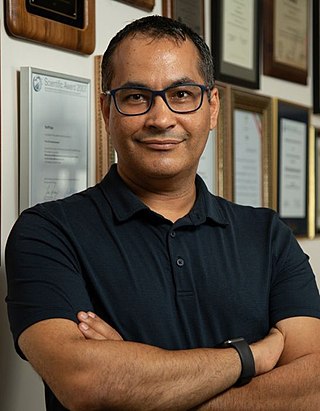
Ali Khademhosseini is the Director and CEO of the Terasaki Institute and former professor at the University of California-Los Angeles where he held a multi-departmental professorship in Bioengineering, Radiology, Chemical, and Biomolecular Engineering and the Director of Center for Minimally Invasive Therapeutics (C-MIT). From 2005 to 2017, he was a professor at Harvard Medical School, and the Wyss Institute for Biologically Inspired Engineering. His studies have been cited ~106,600 times. Khademhosseini is best known for developing hydrogels for tissue engineering and bioprinting.

Nicholas (Nikolaos) A. Peppas is a chemical and biomedical engineer whose leadership in biomaterials science and engineering, drug delivery, bionanotechnology, pharmaceutical sciences, chemical and polymer engineering has provided seminal foundations based on the physics and mathematical theories of nanoscale, macromolecular processes and drug/protein transport and has led to numerous biomedical products or devices.

Arginylglycylaspartic acid (RGD) is the most common peptide motif responsible for cell adhesion to the extracellular matrix (ECM), found in species ranging from Drosophila to humans. Cell adhesion proteins called integrins recognize and bind to this sequence, which is found within many matrix proteins, including fibronectin, fibrinogen, vitronectin, osteopontin, and several other adhesive extracellular matrix proteins. The discovery of RGD and elucidation of how RGD binds to integrins has led to the development of a number of drugs and diagnostics, while the peptide itself is used ubiquitously in bioengineering. Depending on the application and the integrin targeted, RGD can be chemically modified or replaced by a similar peptide which promotes cell adhesion.
Kristi S. Anseth is the Tisone Distinguished Professor of Chemical and Biological Engineering, an Associate Professor of Surgery, and a Howard Hughes Medical Investigator at the University of Colorado at Boulder. Her main research interests are the design of synthetic biomaterials using hydrogels, tissue engineering, and regenerative medicine.
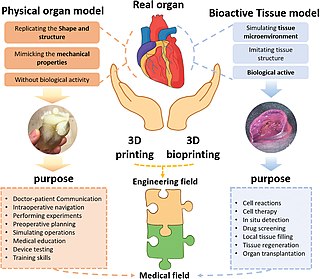
Three dimensional (3D) bioprinting is the utilization of 3D printing–like techniques to combine cells, growth factors, and/or biomaterials to fabricate biomedical parts, often with the aim of imitating natural tissue characteristics. Generally, 3D bioprinting can utilize a layer-by-layer method to deposit materials known as bio-inks to create tissue-like structures that are later used in various medical and tissue engineering fields. 3D bioprinting covers a broad range of bioprinting techniques and biomaterials. Currently, bioprinting can be used to print tissue and organ models to help research drugs and potential treatments. Nonetheless, translation of bioprinted living cellular constructs into clinical application is met with several issues due to the complexity and cell number needed to create functional organs. However, innovations span from bioprinting of extracellular matrix to mixing cells with hydrogels deposited layer by layer to produce the desired tissue. In addition, 3D bioprinting has begun to incorporate the printing of scaffolds. These scaffolds can be used to regenerate joints and ligaments.

Jeffrey Karp is a Canadian biomedical engineer working as a Professor of Medicine at Harvard Medical School, Brigham and Women's Hospital, and the principal faculty at the Harvard Stem Cell Institute and Affiliate Faculty at the Massachusetts Institute of Technology through the Harvard–MIT Division of Health Sciences and Technology. He is also an affiliate faculty at the Broad Institute.

Eugenia Kumacheva is a University Professor and Distinguished Professor of Chemistry at the University of Toronto. Her research interests span across the fields of fundamental and applied polymers science, nanotechnology, microfluidics, and interface chemistry. She was awarded the L'Oréal-UNESCO Awards for Women in Science in 2008 "for the design and development of new materials with many applications including targeted drug delivery for cancer treatments and materials for high density optical data storage". In 2011, she published a book on the Microfluidic Reactors for Polymer Particles co-authored with Piotr Garstecki. She is Canadian Research Chair in Advanced Polymer Materials. She is Fellow of the Royal Society (FRS) and a Fellow of the Royal Society of Canada (FRSC).
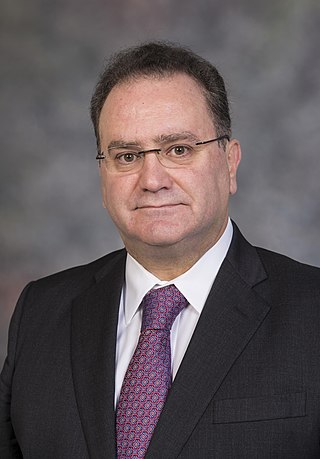
Antonios Georgios Mikos is a Greek-American biomedical engineer who is the Louis Calder Professor of Bioengineering and Chemical and Biomolecular Engineering at Rice University. He specialises in biomaterials, drug delivery, and tissue engineering.
Eleanor Phoebe Jane Stride is a Professor of Biomaterials at St Catherine's College, Oxford. Stride engineers drug delivery systems using carefully designed microbubbles and studies how they can be used in diagnostics.

Joyce Y. Wong is an American engineer who is Professor of Biomedical Engineering and Materials Science and Engineering at Boston University. Her research develops novel biomaterials for the early detection treatment of disease. Wong is the Inaugural Director of the Provost's Initiative to promote gender equality and inclusion in STEM at all levels: Advance, Recruit, Retain and Organize Women in STEM. She is a Fellow of the American Association for the Advancement of Science, American Institute for Medical and Biological Engineering and Biomedical Engineering Society.
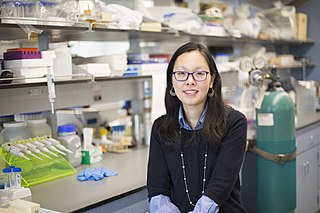
Jin Kim Montclare is a Professor of Chemical and Biomolecular Engineering at New York University. She creates novel proteins that can be used in drug delivery, tissue regeneration and as medical treatment. She is a 2019 AAAS Leshner Leadership Fellow and has been inducted to the AIMBE College of Fellows.
Craig Alexander Simmons is a Canadian mechanobiologist and professor at the University of Toronto. He received a master's degree in mechanical engineering from Massachusetts Institute of Technology and a Ph.D. in mechanical engineering from the University of Toronto. Simmons contributes to the fields of mechanobiology, stem cells, microfluidics and tissue engineering.
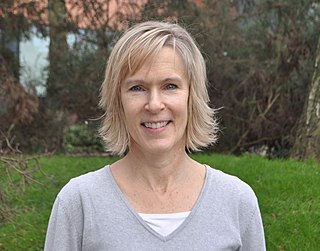
Kristi Lynn Kiick is the Blue and Gold Distinguished Professor of Materials Science and Engineering at the University of Delaware. She studies polymers, biomaterials and hydrogels for drug delivery and regenerative medicine. She is a Fellow of the American Chemical Society, the American Institute for Medical and Biological Engineering, and of the National Academy of Inventors. She served for nearly eight years as the Deputy Dean of the College of Engineering at the University of Delaware.

Debra Auguste is an American chemical engineer and professor at Northeastern University in the Department of Chemical Engineering. Auguste is dedicated to developing treatments for triple negative breast cancer, one of the most aggressive and fatal cancers that disproportionately affects African American women. Her lab characterizes biomarkers of triple negative breast cancer and develops novel biocompatible therapeutic technologies to target and destroy metastatic cancer cells. Auguste received the 2012 Presidential Early Career Award for Scientists and Engineers and in 2010 was named in the 50 Most Influential African-Americans in Technology. In 2020, Auguste became an Elected Fellow of the American Institute for Medical and Biological Engineering.

Milica Radisic is a Serbian Canadian tissue engineer, academic and researcher. She is a professor at the University of Toronto’s Institute of Biomaterials and Biomedical Engineering, and the Department of Chemical Engineering and Applied Chemistry. She co-founded TARA Biosystems and is a senior scientist at the Toronto General Hospital Research Institute.
Shelly R. Peyton is an American chemist who is the Armstrong Professional Development Professor at the University of Massachusetts Amherst. Her research considers the development of biomaterials to investigate metastatic cancer and potential new therapies.
Elizabeth Cosgriff-Hernandez is an American biomedical engineer who is a professor at the University of Texas at Austin. Her work involves the development of polymeric biomaterials for medical devices and tissue regeneration. She also serves on the scientific advisory board of ECM Biosurgery and as a consultant to several companies on biostability evaluation of medical devices. Cosgriff-Hernandez is an associate editor of the Journal of Materials Chemistry B and Fellow of the International Union of Societies for Biomaterials Science and Engineering, Biomedical Engineering Society, Royal Society of Chemistry, and the American Institute for Medical and Biological Engineering.
Surita Bhatia is an American chemist who is Professor and Vice Provost of Faculty Affairs at Stony Brook University. Her work considers the structure of soft materials, including polymeric hydrogels and colloidal glasses. She was elected Fellow of the American Institute of Chemical Engineers, the American Institute for Medical and Biological Engineering and the Society of Rheology in 2020.
Tatiana Segura is an American biomedical engineer who is a professor at Duke University. Her research considers biomedical engineering solutions to promote cell growth. She was elected Fellow of the American Institute for Medical and Biological Engineering in 2017 and awarded the Acta Biomaterialia Silver Medal in 2021.
References
- ↑ "WOMEN FACULTY IN CHEMISTRY DEPARTMENTS IN CANADA" (PDF). Retrieved 15 January 2022.
- ↑ Silcoff, Sean (22 February 2021). "Out of the lab, into the marketplace: How one of Canada's most celebrated scientists, Molly Shoichet, is bringing her key discovery to market". The Globe and Mail. Retrieved 15 January 2022.
- 1 2 "Molly Shoichet named Ontario's first Chief Scientist". University of Toronto News. Retrieved 19 April 2019.
- 1 2 Giovannetti, Justin (4 July 2018). "PCs dismiss Ontario's chief scientist amid broad effort to undo Liberals' legacy". The Globe and Mail. Retrieved 19 April 2019.
- 1 2 3 "The Shoichet Lab | Molly's Bio". www.ecf.utoronto.ca. Retrieved 4 August 2015.
- ↑ "Canadian researcher Molly Shoichet wins L'Oreal/UNESCO For Women in Science Award". CBC. Retrieved 4 August 2015.
- ↑ Semeniuk, Ivan (14 May 2015). "Injectable gel makes inroads against blindness and stroke". Globe & Mail. Retrieved 4 August 2015.
- ↑ "Molly Shoichet Receives TERMIS Senior Scientist Award". chem-eng.utoronto.ca. Retrieved 4 August 2015.
- 1 2 3 4 "Molly Shoichet, science's symphony conductor". University Affairs. Retrieved 5 February 2019.
- ↑ "Metro Morning | New art and science exhibit at Pearson Airport". CBC Listen. Retrieved 5 February 2019.
- ↑ "Artful Science exhibit takes off at Toronto Pearson Airport". The Varsity. 30 September 2018. Retrieved 5 February 2019.
- 1 2 Semeniuk, Ivan (11 November 2020). "University of Toronto researcher awarded Canada's top science prize". The Globe and Mail (Canada). Retrieved 31 January 2021.
- ↑ "30 Appointees Named To Ontario's Highest Honour". 21 January 2011. Retrieved 10 February 2010.
- ↑ "2015 L'Oréal-UNESCO For Women in Science Awards". UNESCO. Archived from the original on 20 March 2015. Retrieved 20 March 2015.
- ↑ "U of T biomedical engineer wins women in science prize". Globe & Mail. 3 March 2015. Retrieved 4 August 2015.
- ↑ "Meet U of T's Inventors of the Year | U of T News". www.news.utoronto.ca. Retrieved 4 August 2015.
- ↑ Kalev Pugi Award Chemical Institute of Canada. Retrieved 18 December 2016.
- ↑ Prestigious Killam Prize for engineering awarded to female scientist second year in a row By Nicole Mortillaro, CBC News, 2 May 2017
- ↑ "Molly Shoichet". NSERC Prizes. Gerhard Herzberg. Winners. Natural Sciences and Engineering Research Council of Canada. 10 November 2020. Retrieved 31 January 2021.